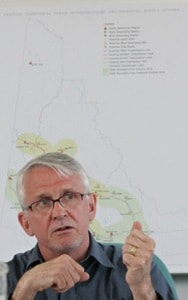The Yukon Energy Corporation has some expensive plans for the future.
In a 20-year resource plan, released Tuesday, the corporation cites four projects to handle projected population and utility growth.
While Yukon Energy creates more hydroelectricity than its customers can use at a given moment, the territory is ill-prepared for a crisis, as it learned in January when a technical breakdown at Aishihik Lake caused power outages in much of southern Yukon.
“This system needs some investment, pure and simple,” said corporation CEO David Morrison.
“We need to be able to lose a component (of the system) and still meet the load of all our customers.”
Yukon Energy already has money in its annual budgets for the less expensive projects, he added.
But taxpayers and mining companies will have to bear some of the more expensive costs.
The most expensive proposal is to build a transmission line between Carmacks and Stewart Crossing, along the North Klondike Highway.
The $32-million project would link the territory’s two major power grids: one in the south, between Whitehorse, Aishihik Lake and Faro, and one in the north, between Mayo and Dawson City.
The Carmacks-Stewart line would provide hydroelectric power to Pelly Crossing, which currently burns diesel fuel for power, and possibly to two new mines scheduled to open in the near future.
Yukon Energy already has a power purchase agreement in place with Sherwood Copper Corporation, which plans to strip an open pit copper mine at Minto this summer and launch production in 2007.
And Yukon Energy is “confident” that Western Copper will begin production at Carmacks Copper by 2008, said Morrison.
Yukon Energy will likely ask the Yukon government to pay half the tab, or roughly $15 million, he said.
The mines will likely have to pay a portion of the construction costs as well, he added, without giving an estimated sum each mine would be asked to pay.
The next most expensive proposal is to build a third hydro turbine at Aishihik Lake.
The Aishihik facility currently produces about 30 megawatts of energy with two turbines.
Combined with about 24 megawatts from the Whitehorse hydro facility and power from community diesel generators from Faro to Haines Junction, the southern grid currently produces a maximum allowable peak load of 68.7 megawatts.
Building a third turbine at Aishihik, for $7 million, would boost production of the southern grid by seven megawatts.
The third proposal is not intended to boost production, unless there is an emergency.
Yukon Energy wants to overhaul three 35-year-old Merlee diesel engines at Whitehorse for $6.3 million, adding 12,000 hours of life to the machines and holding 11.4 megawatts in strict reserve.
“We keep the diesels turned off,” said Morrison.
“That’s part of the idea here.
“We refurbish them, but we keep them as a backup.”
The fourth proposal would not boost production either, but it would allow more control of the Marsh Lake reservoir.
Yukon Energy is seeking an amendment to its water licence that would allow it to open the floodgates at Marsh Lake later than August 15, possibly raising the lake surface by 0.3 metres higher than is currently allowed.
The extra water would increase winter power at the Whitehorse hydro facility by 1.3 megawatts.
However, Yukon Energy expects to hear concerns from cottage owners around Marsh Lake.
“There may well be some shoreline erosion protection that’s needed,” said Hector Campbell, director of resource planning and chief information officer for Yukon Energy.
Consultation with Marsh Lake residents will commence this summer, said Morrison.
Yukon Energy will hold public consultations for all four
proposals, before any of them proceed, he said.
Morrison admitted that summer is not the ideal time to do public consultation.
But Yukon Energy is under the gun to get at least one of the projects moving forward, he said.
Yukon Energy has promised to do its best to pipe power in to the two mines by 2008.
It will take about a year to construct phase one of the Carmacks-Stewart transmission line, from Carmacks to Pelly, said Morrison.
If Yukon Energy wants to begin construction by spring 2007, it will need all the requisite permits, including an assessment from the new Yukon Environmental and Socioeconomic Assessment Board, in less than a year.
Once they start buying power from Yukon Energy, the mines should serve as downward rate drivers, since they’ll be purchasing lots of electricity for about $6 million per year, said Morrison.
But none of the proposals necessarily need mines in production in order to make economic sense for the territory’s future, he said.
However, “we wouldn’t necessarily do some of these if there is no mining,” said Morrison.
Yukon Energy doesn’t plan to expand its wind power program.
The two windmills atop Haeckel Hill contribute very little power to the Whitehorse-Aishihik- Faro grid.
But there are also no plans for major power-generating projects, said Morrison.
“There are no plans in here to build a great big dam or a coal-fired generating plant,” he said.
The 20-year plan was offered to the Yukon Utilities Board for approval on June 1.
